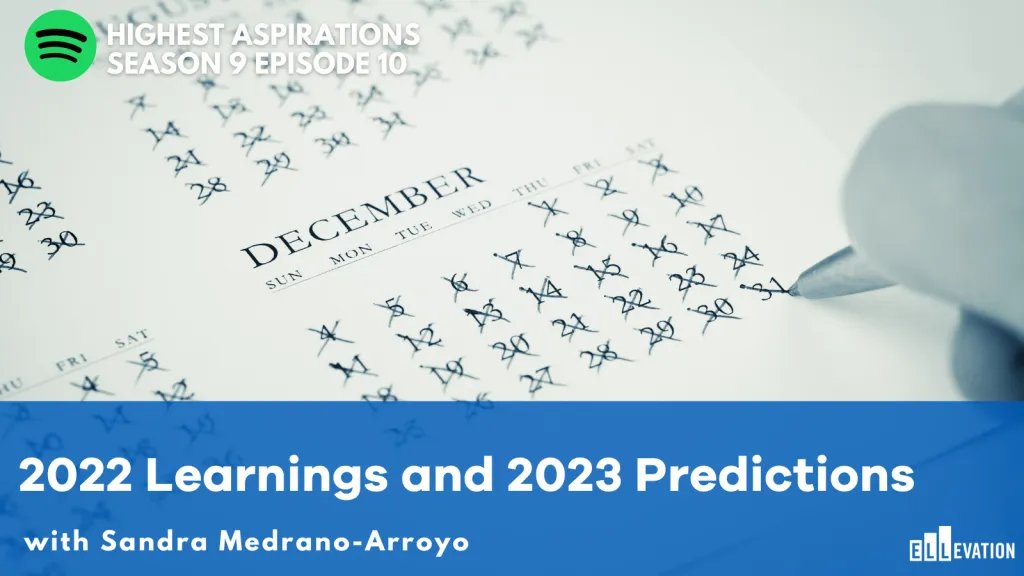EL Education: 2022 learnings and 2023 predictions


EL Education: 2022 learnings and 2023 predictions
It has been quite a year for EL education! We were lucky to have a well-loved return guest for our final interview of 2022 to take a look back. Sandra Medrano-Arroyo is Ellevation’s own Dual Language Instructional Content Specialist with over 20 years of multilingual education experience as an educator. We first spoke with Sandra about a year ago in a two part podcast series on how to create high-quality dual language programs (find part one and two here).
We recently caught up with Sandra to hear about her busy year of launching a total of 27 professional learning modules in our Strategies product and returning to the in-person conference circuit as both an attendee and presenter.
As an instructional content creator, consultant for NABE and dual language expert, she has her finger on the pulse of multilingual education. Sandra shares her most notable observations from the EL education space over the past year and her predictions for what next year will bring:
3 Key Learnings from 2022
1. Expectations for Increased Family Engagement
During the pandemic, our classrooms were brought into students’ homes, which inadvertently opened a new door for family advocacy. Parents and families had a glimpse of what their childs’ education looked like, and realized they should know more.
“You take your child to school and you have certain expectations as their parent or guardian, the expectation is that they're going to be safe, they're going to be taught, and they're going to become contributors to a greater society. And I think that families have now changed, they've shifted their mindset a little bit about wanting to be, or play a greater role in that learning community,” Sandra explains.
The increased involvement and communications families experienced during the pandemic is a “new normal” and something Sandra has found that they expect to continue now that schools have reopened.
2. Students’ entire linguistic repertoires are more widely accepted
“I think more people are open to the idea of culture and language being one, you can't separate the two. And what can we learn about culture through language as well as what do we learn about language through culture?” she shares.
Sandra has seen an increased acceptance for the need to tap into the language that our students are bringing into the classroom and to see our students as one whole child composed of all their languages and cultures, rather than reduced to each individual part.
3. Digital learning’s evolving role for students and teachers
Digital learning had a different role for students and teachers over the past year. Sandra observed that in most cases, education has shifted very closely back to its pre-pandemic form, and much of the technology tools used for remote learning have not been continued.
However she advises educators to remember that their students are digital natives, and we should be preparing them for their future work life experience which will be deeply steeped in the digital world.
To contrast, Sandra has found that the digital learning educators turned to during the pandemic is here to stay.
“Online PD affords that convenience, that flexibility factor. The key though is going to be how are we as administrators, school and district administrators, how are we going to bring teachers together to reflect on those learnings? Because that's really where all of that, that's where it can create that change. That reflection is also going to help our teachers from burning out.”
3 Trends to Look Out for in 2023
1. A greater focus on equitable education
“More people are being more vocal about prioritizing equity, more conversations are being had about this. We can't forget what happened to us as a society. Our kids are suffering the repercussions of that and need individualized support,” she explains.
Sandra predicts a bigger focus on ensuring that schools are providing all students with the resources they need to reach their educational goals. For educators, this includes improving the process of disaggregating student data and taking a “whole child” approach to instruction.
2. Results from tutoring programs and pivoting accordingly
After returning from remote learning during the pandemic, there was a significant amount of unfinished learning needing to be addressed. A variety of tutoring programs and approaches were put into place, but Sandra cautions to measure expectations for academic gains as results come out in the coming year.
“We're going to see that if they didn't lay the groundwork early on, we may not see the changes that we expected… The prediction really is that those schools who did something different for tutoring to really dig into the gaps and strategic or intentional about it - I think those are the ones that we'll see the largest academic gains.”
3. Flourishing school communities and partnerships
Sandra hopes for schools to shift away from working in a silo to a more connected approach, and recommends that administrators prioritize creating partnerships and strong bonds throughout their community.
She ends by sharing a quote from one of her favorite books Beyond Crises:
“‘The student, their family, classroom, schools, communities, they're part of a larger whole that is interrelated and interconnected and even interdependent on each other.’ That just blew me away. I thought, ‘Why are we not seeing this more?’ I think it truly sets the tone for changing the way we do things, focusing on creating those partnerships and those strong bonds is how our multilingual learners are going to achieve success.”
Download the full episode transcript here.
Episode resources:
- Beyond Crises
- Guiding Principles for Dual Language Education
- Work by Dr. Escamilla, Dr. Gottlieb, The Freemans
- Advancing Equity for Dual Language Education
- EL Community blog